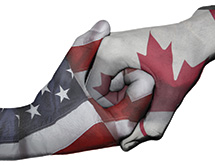Canada’s Southern Neighbor

As a Canadian business looking to expand distribution, it seems obviously beneficial to start with the United States. The U.S. has over 283 million more citizens than Canada’s 35.2 million, making for abundant opportunity to increase profits and amplify your company’s growth after launching your product there.
Canada ships an incredible amount of goods to the U.S. each year and in 2013 exports to the U.S. amounted to an incredible $332.1 billion. According to The Office of the United States Trade Representative, that’s a 77 percent increase since 2003. In a 2013 statement, Foreign Affairs, Trade and Development Canada (FATDC) pointed out that the recovering economy in the United States helped to boost the overall demand for Canadian products, marking the fourth consecutive year that saw a significant increase of Canadian exports to the United States.
Trade between the U.S. and Canada is flourishing thanks to its close proximity to Canada, the size of the U.S. economy, and various trade agreements – like the North American Free Trade Agreement (NAFTA), the Canada-U.S. Air Transport Agreement and the Canada-U.S. Government Procurement.
In the U.S. there is a healthy demand for goods manufactured in Canada, everything ranging from pharmaceuticals, food and tech, to other specialty goods. Canadian business owners, executives and other decision-makers should not only consider exporting products to the United States, but should build a strategic plan and implement it efficiently. When properly managed, expanding business into the U.S. can be an extremely profitable endeavor for a knowledgeable company.
But how exactly does a Canadian business owner go about exporting products to the U.S.? As noted by Small Business BC, it’s important to start by preparing an export plan and conducting market analysis to determine where the demand for your particular product is within the United States.
It’s critical that you start with research and one of the best ways, for example, is by monitoring social media activity to track buyer behavior. Having extensive knowledge of the American consumer will help ensure you are meeting a consumer demand with little to no competition in the marketplace.
Incorporating E-commerce
One very important characteristic to understand about American shoppers is that e-commerce shopping is quickly becoming the norm for many, if not most Americans. In the first quarter of 2015, the total amount of U.S. retail e-commerce sales totaled $80.3 billion. By incorporating e-commerce capabilities into your strategy you will mostly help, not hurt, sales – especially as people continue to make purchases on their wireless devices.
For many Americans, e-commerce shopping is easier than going into a traditional retail store and even better for purchasing products not yet available for purchase in the U.S. E-commerce allows for small businesses to sell to consumers from all over the world; however, as you begin receiving orders and start preparing to ship the products from Canada to your customers, be aware that the process involves the management of customs, duties, and cross-border transportation.
E-commerce purchases are a leading reason why you should prearrange logistics for shipping prior to products crossing the Canadian-American border. Work with a licensed customs broker to determine if the goods you’ll be exporting are controlled, regulated or prohibited by either the Canadian or American governments. Make sure to also guarantee the products you are shipping can legally leave Canada because the government does regulate certain items.
U.S. Customs and Border Protection has their own set of requirements and they also enforce laws and regulations by other U.S. government agencies that may prohibit or limit entry, restrict storage or use, or require labeling as a condition of release for certain products. Thanks to NAFTA, most products shipped into the U.S. may not need to be reported, although you should definitely check with the Canada Border Services Agency (CBSA) to see if any specialty packages, permits or labeling are required for your products.
Next, you’ll have to make the decision of how you will physically ship the products across the border. A variety of goods can be shipped via truck, bus, rail (ideal for large bulk), air, standard mail or private courier.
For most small-to-medium-sized businesses only just beginning to sell to the U.S. market, shipping by truck is an affordable and practical option. Depending on the type of product, however, you’ll want to be sure to choose the delivery method that makes the most sense for your preferred delivery timeline and shipping costs.
Working Together
There are various rules and regulations involved in shipping products into the United States, so it is recommended to partner with a vendor who is familiar with the entire process.
A number of companies specialize in shipping and distributing Canadian goods, and many have the infrastructure for warehousing and transportation – the final and critical components in order to reach your U.S. consumers timely and efficiently. Working with a logistics partner that specializes in all cross-border logistics including shipping, customs clearance and regulatory matters will ensure that the international expansion runs smoothly and in the end provides a seamless experience for the end customer.
As demand for Canadian products continues to increase in the U.S., having an international business strategy and a way to properly manage logistics, will make shipping goods to U.S. customers a simple and prosperous effort. The apparent likelihood that consumers will continue to purchase products from global markets via e-commerce is another enticing notion that should compel your business to setup user-friendly e-commerce platforms with fair shipping costs to meet the needs of new consumers. By utilizing e-commerce and working with a dedicated Canadian company who can help manage cross-border shipping and fulfillment, you will be able to successfully tap into the U.S. marketplace.